
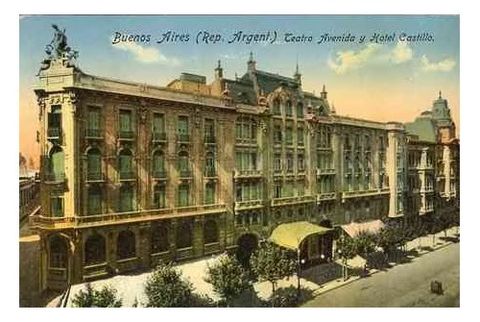
The Avenida Theatre (Teatro Avenida) is a theatre in Buenos Aires, Argentina.


The Avenida Theatre (Teatro Avenida) is a theatre in Buenos Aires, Argentina.
The Avenida Theatre was inaugurated on Buenos Aires' central Avenida de Mayo in 1908 with a production of Spanish dramatist Lope de Vega's Justice Without Revenge. The production was directed by María Guerrero, a Spanish Argentine theatre director who popularized classical drama in Argentina during the late 19th century and would establish the important Cervantes Theatre in 1921. The theatre became the chief venue for Spanish theatre in Buenos Aires after the conversion of the Cervantes into the National Comedy Theatre in 1933 and Federico García Lorca's play Bodas de Sangre was staged there that year. It soon earned renown for its varied operettas and zarzuelas (many led by renowned Spanish theatre director Federico Moreno Torroba), as well as for special events, such as a 1939 production of Aida for the benefit of Spanish charities dealing with the aftermath of that country's Civil War.

The production of Spanish theatre at the Avenida declined after 1960, and the Avenida turned to Broadway theatre productions instead. One early success was the local 1963 production of Cole Porter's Kiss Me, Kate . Varying its repertoire, the Avenida featured a production of Giuseppe Verdi's La Traviata in 1967 and the theatre's purchase by local impresario Faustino García helped lead to Moreno Torroba's return in 1970 and a revival of the Avenida's erstwhile standby, the zarzuela, during that decade.
The advent of Argentina's last military dictatorship in 1976 led to an abrupt decline in local theatre activity, leading to the Avenida's closure in 1977. A 1979 fire nearly destroyed the Avenida, and the theatre remained shuttered until its reopening on 19 June 1994. However, the original building's top section, which included the former Hotel Castilla, were not restored.
With the closure of the city's Teatro Colón, which started refurbishment in October 2006, the Avenida picked up its classical opera programming, and in the past few years both Buenos Aires Lírica alongside Juventus Lírica, consisting mostly of promising young voices, staged humble productions of major titles such as Puccini's Madama Butterfly , Bizet's Carmen , Verdi's Aida and La Traviata , Mozart's The Magic Flute and The Marriage of Figaro , Rossini's The Barber of Seville , amongst others.
| Wikimedia Commons has media related to Avenida Theatre . |

Zarzuela is a Spanish lyric-dramatic genre that alternates between spoken and sung scenes, the latter incorporating operatic and popular songs, as well as dance. The etymology of the name is uncertain, but some propose it may derive from the name of a Royal hunting lodge, the Palacio de la Zarzuela near Madrid, where, allegedly, this type of entertainment was first presented to the court. The palace was named after the place called "La Zarzuela" because of the profusion of brambles (zarzas) that grew there, and so the festivities held within the walls became known as "Zarzuelas".

The Teatro Colón is the main opera house in Buenos Aires, Argentina. It is considered one of the ten best opera houses in the world by National Geographic, and is acoustically considered to be amongst the five best concert venues in the world.
The Conservatorio Nacional Superior de Música is the national music conservatory for Argentina and it is located in Buenos Aires.

Federico Moreno Torroba was a Spanish composer, conductor, and theatrical impresario. He is especially remembered for his important contributions to the classical guitar repertoire, becoming one of the leading twentieth-century composers for the instrument. He was also one of the foremost composers of zarzuelas, a form of Spanish light opera. His 1932 zarzuela, Luisa Fernanda, has proved to be enduringly popular. In addition, he composed ballets, symphonic works, and piano pieces, as well as one-act operas and one full-length opera, El poeta, which premiere in 1980, starring well-known tenor Plácido Domingo. Moreno Torroba also ran his own zarzuela company, which toured extensively, especially in Latin America.

Hariclea Darclée was a celebrated Romanian operatic soprano of Greek origin who had a three-decade-long career.
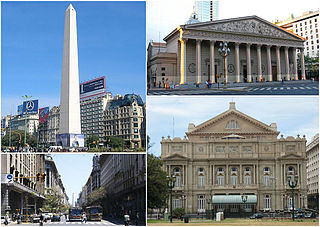
San Nicolás is one of the neighbourhoods of the city of Buenos Aires, Argentina, sharing most of the city and national government structure with neighboring Montserrat and home to much of Buenos Aires' financial sector. It's seldom referred to as San Nicolás, but usually as El Centro, and the part east of the 9 de Julio Avenue is known as Microcentro. The limits of the neighbourhood are the Córdoba, Callao, Rivadavia, La Rábida Norte and Eduardo Madero Avenues. The district is home to 33,305 inhabitants.

Avenida Corrientes is one of the principal thoroughfares of the Argentine capital of Buenos Aires. The street is intimately tied to the tango and the porteño sense of identity. Like the parallel avenues Santa Fe, Córdoba, and San Juan, it takes its name from one of the Provinces of Argentina.

Marcelo Raúl Álvarez is an Argentine lyric tenor who achieved international success starting in the mid-1990s.
Luisa Fernanda is a romantic zarzuela in three acts by Federico Moreno Torroba. It has been performed more than 10,000 times. The libretto, in Spanish, is by Federico Romero and Guillermo Fernández Shaw. The first performance took place at Teatro Calderón in Madrid on 26 March 1932. It was Moreno Torroba’s fourth zarzuela, his first to receive great acclaim.

The Teatro Nacional Cervantes in Buenos Aires is the national stage and comedy theatre of Argentina.

María Guerrero Torija was a prominent Spanish theatre actor, producer and director.

Patio Bullrich is an important shopping center in the Retiro section of Buenos Aires.

Hotel Castelar is located at the northwest intersection of May and the 9 de Julio Avenues, in the downtown Montserrat section of Buenos Aires, Argentina.

Punto Obelisco is a zone around the Obelisk of Buenos Aires and the Plaza de la República. It is a project held by the city's government in order to enrich the surroundings of the monument and to make it the center of entertainment in the city. A zone combining the theatres avenue and the lights of LED signs taking inspiration from Times Square in New York City, the Shibuya Crossing in Tokyo and Piccadilly Circus in London and runs through Avenida 9 de Julio between Rivadavia Avenue and Córdoba Avenue. It also includes a ticket sales stand.
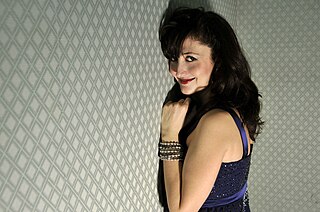
María José Montiel is a Spanish mezzo-soprano opera singer born in Madrid. In 2011 she was awarded the Premio Teatro Campoamor for her interpretation of Carmen by the Fundación Premio Líricos Teatro Campoamor.
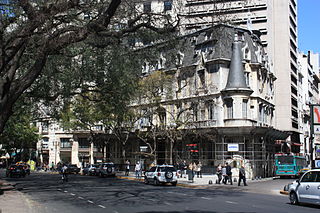
The Palacio Haedo is a 19th-century building on the Avenida Santa Fe in Buenos Aires, Argentina. It is located to the south of the Torre de Los Ingleses and the Plaza San Martín and Monument del libertador Jose de Plaza San Martín, in close proximity to the Consulate of Colombia and the Gran Hotel Buenos Aires. It was built in the late 19th century as a residence for the Haedo family by architects Passeroni and Brizuela in the Neo-Gothic style.

Plácido Domingo Ferrer was a Spanish zarzuela baritone and father of popular operatic tenor Plácido Domingo. Half Catalan and half Aragonese, he grew up and made his early career in Zaragoza, the capital of Aragon. He frequently toured Spain with his soprano wife Pepita Embil. In late 1948, they permanently moved to Mexico, where they successfully ran their own zarzuela company. He also appeared in recordings and on Mexican television.
El poeta is a Spanish opera composed by Federico Moreno Torroba. It premiered at the Teatro de la Zarzuela in Madrid, Spain on June 19, 1980, starring Plácido Domingo, Ángeles Gulín, and Carmen Bustamante. The idea of a new opera had originally been suggested to Moreno Torroba by Domingo. El poeta would be the 89-year-old composer's last major work for the stage.

Cecilio Madanes was a Ukrainian theater director, set designer, and producer. He was one of the leading figures in Argentine theatre from 1950 through 1960. Madanes founded the Teatro Caminito.
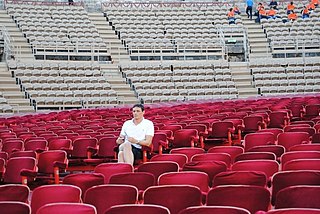
Stefano Trespidi is an Italian opera stage director.